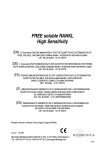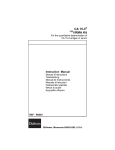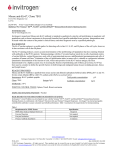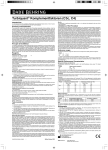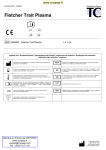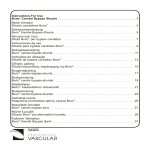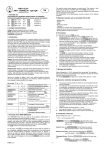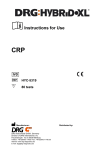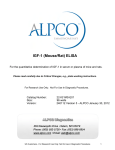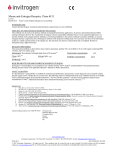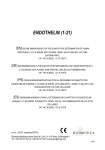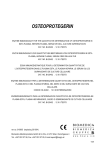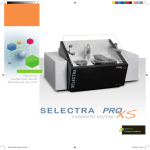Download OLAB IgG ANTI OXIDISED LOW DENSITY LIPOPROTEIN
Transcript
OLAB IgG ANTI OXIDISED LOW DENSITY LIPOPROTEIN ENZYME IMMUNOASSAY FOR THE QUANTITATIVE DETERMINATION OF HUMAN IgG AUTOANTIBODIES AGAINST OXIDISED LOW DENSITY LIPOPROTEIN IN SERUM CAT. NO. BI-20032. 12 X 8 TESTS ENZYMIMMUNOASSAY ZUR QUANTITATIVEN BESTIMMUNG VON HUMANEN IgG AUTOANTIKÖRPERN GEGEN OXIDIERTES LOW DENSITY LIPOPROTEIN IN SERUM. KAT. NR. BI-20032. 12 X 8 TESTS ENZIMOINMUNOENSAYO PARA LA DETERMINACION CUANTITATIVA DE IgG AUTOANTICUERPOS CONTRA LA FORMA OXIDADA DE LDL EN SUERO CAT. NO. BI-20032. 12 X 8 TESTS rev.no. 141028 (replacing 080606) Biomedica Medizinprodukte GmbH & Co KG, A-1210 Wien, Divischgasse 4 Tel. +43/1/291 07 45, Fax +43/1/291 07 85, E-mail [email protected] 1/16 CONTENT / INHALT / CONTENIDO 1) 2) 3) ENGLISH ..... 3 DEUTSCH .... 7 ESPANIOL … 11 Additional information on our products is available on our website. Zusätzliche Information zu unseren Produkten ist auf unserer Homepage erhältlich. Encontrará información adicional sobre nuestros productos en nuestra página web. www.bmgrp.com 2/16 1) INTRODUCTION Oxidized low density lipoprotein (oLDL) is believed to play a critical role in the development and progression of atherosclerosis. Accumulation of oLDL in macrophages and smooth muscle cells causes foam cell formation, an initial step in the disease. Autoantibodies against oxidatively modified LDL can be used as a parameter that consistently mirrors the occurrence of oxidation processes taking place in vivo. In fact, elevated levels of autoantibodies against oLDL have been detected in the blood stream of patients with coronary artery disease. Moreover, recent studies indicate a correlation between autoantibodies against oLDL and the progression of carotid atherosclerosis. Increased serum concentrations of oLAB have also been described in various diseases such as pre-eclampsia and systemic lupus erythematosus. Decreased oLAB titers were observed during septicemia and myocardial infarction. An overview on the clinical applications of oLAB has been published. POSSIBLE INDICATIONS • atherosclerosis • coronary artery disease • risk stratification from myocardial infarction • acute septicemia 2) CONTENTS OF THE KIT CONT KIT COMPONENTS QUANTITY PLATE Oxidised LDL coated microtiterstrips in stripholder packed in alubag with desiccant 12 x 8 tests ASYBUF Assay buffer, red cap, ready to use 1 x 60 ml WASHBUF Wash buffer concentrate 20x, natural cap 1 x 50 ml STD Standards (37, 75, 150, 300, 600, 1,200 mU/ml oLAB IgG), white caps, ready to use 6 x 500 µ l CTRL Controls (300, 1,000 mU/ml), yellow caps, ready to use 2 x 500 µ l CONJ Conjugate, (monoclonal anti human IgG-HRPO), amber cap, ready to use 1 x 13 ml SUB Substrate (TMB solution), blue cap, ready to use 1 x 13 ml STOP Stop solution H2SO4, white cap, ready to use 1 x 7 ml 3) ADDITIONAL MATERIAL INCLUDED IN THE KIT • 2 self-adhesive plastic films • 1 uncoated microtiter plate for sample dilution • QC protocol • Protocol sheet • Instruction manual for use 4) MATERIAL AND EQUIPMENT REQUIRED BUT NOT SUPPLIED • Incubator for 37°C • Precision and multichannel pipettes calibrated to deliver 20 µ l, 50 µ l, 100 µ l, and 200 µ l and disposable tips • ELISA reader for absorbance at 450 nm (or from 450 nm to 630 nm) • Graph paper or software for calculation of results • Plate washer is recommended for washing • Distilled or deionised water 3/16 5) REAGENTS AND SAMPLE PREPARATION All reagents as supplied in the kit are stable at 4°C (2-8°C) until expiry date stated on the label of each reagent. Samples should be stored at -20°C if not assayed on the same day, long term storage at -70°C. Do not use lipemic or haemolysed samples. Samples should be mixed well before assaying. The test system is not designed for plasma. WASHBUF (Wash buffer): Dilute the concentrate 1:20 (e.g. 50 ml WASHBUF + 950 ml distilled water). Crystals in the buffer concentrate will dissolve at room temperature. Undiluted WASHBUF is stable at +4°C (2-8°C) until expiry date stated on label. Diluted buffer is stable at +4°C (2-8°C) for one month. Use only diluted WASHBUF for the assay performance. PREDILUTION: All STD/SAMPLE/CTRL (standard/sample/control) must be used in 1:55 end-dilution (pre-dilution 1:5 + assay-dilution 1:11) in the assay. Use the enclosed uncoated microtiter plate for the 1:5 pre-dilution step. • Add 200 µ l ASYBUF (Assay buffer) into the appropriate wells of the uncoated microtiter plate. • Add 50 µ l STD/SAMPLE/CTRL (standard/sample/control) into the wells, mix well (=1:5 dilution). Note: Pre-diluted material must be used in the assay within 15 minutes. Follow chapter 7) ASSAY PROTOCOL! 6) PRINCIPLE OF THE ASSAY 7) ASSAY PROTOCOL All reagents and samples must be at room temperature (18-24°C) before use in the assay. Mark position for BLANK/STD/SAMPLE/CTRL (Blank/Standard/Sample/Control) on the protocol sheet. Take microtiter strips out of the alu bag, take a minimum of one well as Blank. Store unused strips with desiccant at +4°C (2-8°C) in the alu bag. Strips are stable until expiry date stated on the label. Add 200 µ l ASYBUF (Assay buffer) into respective wells of the coated microtiter strips, including blank. Add 20 µ l 1:5 pre-diluted STD/SAMPLE/CTRL into each well except blank, swirl gently. ATTENTION: The transfer of the pre-diluted STD/SAMPLE/CTRL into the coated microtiter strips must be completed within 15 minutes. Use a Multichannel pipette. Cover tightly and incubate for 1.5 hours at 37°C. Aspirate and wash wells 4x with 300 µ l diluted WASHBUF (Wash buffer). Remove remaining WASHBUF by hitting plate against paper towel after the latest wash. Add 100 µ l CONJ (Conjugate) into each well except blank. Cover tightly and incubate for 30 minutes at room temperature (18-24°C). 4/16 Aspirate and wash wells 4x with 300 µ l diluted WASHBUF (Wash buffer), remove remaining WASHBUF by hitting plate against paper towel after the latest wash. Add 100 µ l SUB (Substrate) into each well. Incubate for 15 min at room temperature (18-24°C) in the dark. Add 50 µ l STOP (Stop solution) into each well. Measure absorbance immediately at 450 nm with reference 630 nm, if available. 8) CALCULATION OF RESULTS Subtract the blank extinction from all other values. Construct the standard curve from the standard values. Use commercially available software or graph paper. Obtain sample concentration from this standard curve. Respective dilution factors have to be considered. If the concentration of oLAB IgG in the sample exceeds 1,100 mU/ml, further dilution and measurement of the diluted sample is recommended. The quality control protocol supplied with the kit shows the results of the final release QC for each kit. Data for optical density obtained by customers may differ due to various influences and/or due to the normal decrease of signal intensity during shelf life. However, this does not affect validity of results as long as an optical density of 1.00 or higher is obtained for the standard with the highest concentration. 9) ASSAY CHARACTERISTICS Median: 263 mU/ml (n = 50) Normal range: Each laboratory has to establish its own reference range for the samples under investigation. Standard range: 37 to 1,200 mU/ml Sample volume: 50 µ l human serum Detection Limit: 48 mU/ml (37 mU/ml + 3x SD) Incubation time: 1.5 h / 30 min / 15 min 10) PRECISION Sample 1 Sample 2 119 324 SD (mU/ml) 4 14 SD (mU/ml) CV% 4 4.3 CV% Intra-Assay (n=8) Mean (mU/ml) Inter-Assay (n=5) Mean (mU/ml) Sample 1 Sample 2 139 544 11 22 8 4 1) TECHNICAL HINTS • Do not mix or substitute reagents with those from other lots or sources. • Do not mix stoppers and caps from different reagents or use reagents between lots. • Do not use reagents beyond expiration date. • Protect reagents from direct sunlight. • Substrate solution should remain colourless until added to the plate. • To ensure accurate results, proper adhesion of plate sealers during incubation steps is necessary. • Avoid foaming when mixing reagents. 5/16 12) PRECAUTIONS All test components of human source were tested against HIV-Ab and HBsAg and were found negative. Nevertheless, they should be handled and disposed as if they were infectious. Liquid reagents contain ≤0.1% Proclin 300 as preservative.. Avoid contact with skin and mucous membrane. Proclin 300 is not toxic in concentrations used in this kit. It may cause allergic skin reactions, avoid contact with skin or eyes. • Do not pipette by mouth. • Do not eat, drink, smoke or apply cosmetics where reagents are used. • Avoid all contact with reagents by using gloves. • Sulfuric acid is irritating to eyes and skin. Flush with water if contact occurs. Avoid contact with skin and mucous. Irritations are possible – Flush with water after contact! 13) LITERATURE • “Evaluation of the atherogenic tendency of lipids and lipoprotein content and their relationships with oxidant-antioxidant system in patients with psoriasis” Vanizor Kural B. et al. Clin Chim Acta 2003 Feb;328(1-2):71-82 • “Circulating autoantibodies to oxidized LDL correlate with impaired coronary endothelial function after cardiac transplantation” Fang JC et al. Arterioscler Thromb Vasc Biol 2002 Dec 1;22(12):2044-8 • “Autoantibodies to malondialdehyde-modified low-density lipoprotein in patients with angiographically confirmed coronary artery disease” McDowell A. et al. J Pharm Pharmacol 2002 Dec;54(12):1651-7 6/16 1) EINLEITUNG Oxidiertes Low Density Lipoprotein (oLDL) ist offenbar ein wichtiger Faktor bei der Entstehung und Entwicklung von Atherosklerose. In Makrophagen und glatten Muskelzellen akkumuliert oLDL und bewirkt dadurch die Entstehung von Schaumzellen, die Grundlage für die Entstehung der Krankheit. Neue Untersuchungen zeigen, dass die Konzentration von Autoantikörpern gegen oxidativ verändertes LDL die ablaufenden Oxidationsprozesse wiederspiegelt. Hohe Konzentrationen von Autoantikörpern gegen oLDL wurden im Serum von Patienten mit Herzkranzgefäßerkrankungen gemessen. Außerdem zeigen aktuelle Studien eine Korrelation zwischen Autoantikörpern gegen oLDL und fortschreitender Karotid-Atherosklerose. Erhöhte Serumkonzentrationen an oLAB wurden auch bei verschiedenen anderen Erkrankungen wie Präeklampsie und systemischem Lupus erythematodes beschrieben. Niedrige Werte wurden bei akutem Herzinfarkt und Sepsis beobachtet. Ein Überblick über die klinische Wertigkeit von oLAB wurde veröffentlicht. Mögliche INDIKATIONEN • Arteriosklerose • Koronare Herzerkrankung • Risikoabschätzung von Herzinfarkten • Akute Sepsis 2) INHALT DES KITS CONT KIT KOMPONENTEN MENGE PLATE Oxidiertes LDL, beschichtet auf Mikrotiterplattenstreifen im Streifenhalter. Verpackt im Alu Beutel mit Trockenmittel 12 x 8 Teste ASYBUF Verdünnungspuffer, rote Kappe, gebrauchsfertig 1 x 60 ml WASHBUF Waschpuffer, 20fach Konzentrat, durchsichtige Kappe 1 x 50 ml STD Standards (37, 75, 150, 300, 600, 1.200 mU/ml oLAB IgG), weiße Kappen, gebrauchsfertig 6 x 500 µ l CTRL Kontrollen (300, 1.000 mU/ml), gelbe Kappen, gebrauchsfertig 2 x 500 µ l CONJ Konjugat (monoklonal anti human IgG-HRPO), braune Kappe, gebrauchsfertig 1 x 13 ml SUB Substrat (TMB Lösung), blaue Kappe, gebrauchsfertig 1 x 13 ml STOP Stopp Lösung H2SO4, weiße Kappe, gebrauchsfertig 1 x 7 ml 3) ZUSÄTZLICHES MATERIAL IM KIT • 2 selbstklebende Abdeckfolien • 1 unbeschichtete Mikrotiterplatte zur Vorverdünnung • Arbeitsanleitung (Beipacktext) • QC Protokoll • Protokoll Blatt 4) ZUSÄTZLICH BENÖTIGTES MATERIAL UND GERÄTE • Inkubator für 37°C • Kalibrierte Präzisionspipetten bzw. Mehrkanalpipette für 20 µ l, 50 µ l, 100 µ l und 200 µ l, inkl. Pipettenspitzen • Mikrotiterplattenphotometer mit 450 nm Filter (630 nm Referenz) • Millimeterpapier oder Software • Mikrotiterplatten Wascher wird empfohlen • Destilliertes oder deionisiertes Wasser 7/16 5) REAGENZIEN UND PROBENVORBEREITUNG Alle gebrauchsfertigenReagenzien des Kits sind bei 4°C (2-8°C) bis zum Ablaufdatum (siehe Etikett des Reagenz) haltbar. Proben müssen bei -20°C gelagert werden, falls sie nicht am gleichen Tag getestet werden. Für eine Langzeitlagerung empfehlen wir -70°C. Lipämische und hämolytische Proben können falsche Ergebnisse liefern und dürfen nicht verwendet werden. Proben vor Verwendung gut mischen. Humane Plasma Proben dürfen nicht verwendet werden. WASHBUF (Waschpuffer): Das mitgelieferte Konzentrat wird 1:20 verdünnt (zB. 50 ml WASHBUF + 950 ml destilliertes Wasser). Kristalle im Pufferkonzentrat lösen sich bei Raumtemperatur auf. Unverdünnter WASHBUF ist bei +4°C (2-8°C) bis zum Ablaufdatum haltbar. Der verdünnte WASHBUF ist bei +4°C (2-8°C) bis zu einem Monat haltbar. Im Testsystem darf nur verdünnter WASHBUF verwendet werden. VORVERDÜNNUNG: Alle STD/SAMPLE/CTRL (Standard/Proben/Kontrolle) müssen im Test 1:55 (Vorverdünnung 1:5 + Testverdünnung 1:11) endverdünnt werden. Verwenden Sie die unbeschichtete Mikrotiterplatte für den 1:5 Vorverdünnungsschritt. Gehen Sie wie folgt vor: • Pipettieren Sie 200 µ l ASYBUF (Verdünnungspuffer) in die vorgesehenen Wells der unbeschichteten Mikrotiterplatte. • Pipettieren Sie 50 µ l STD/SAMPLE/CTRL (Standard/Proben/Kontrollen) in die Wells, gut mischen. Achtung: Verwenden Sie vorverdünnte Proben innerhalb von 15 Minuten. Für den weiteren Testansatz folgen Sie Kapitel 7) TESTPROTOKOLL. 6) TESTPRINZIP 7) TESTPROTOKOLL Im Test dürfen nur Reagenzien und Proben verwendet werden, welche Raumtemperatur (18-24°C) aufweisen. Markieren Sie die Positionen für BLANK/STD/PROBE/CTRL (Leerwert/Standard/Probe/Kontrolle) am Protokollblatt. Nehmen Sie die benötigten Mikrotiterstreifen aus dem Alu Beutel. Mindestens 1 Well für den Leerwert reservieren. Nicht verwendete Mikrotiterstreifen können mit Trockenmittel im Alu Beutel bis zum angegebenen Ablaufdatum gelagert werden. 8/16 Pipettieren Sie 200 µ l ASYBUF (Verdünnungspuffer) in die entsprechenden Wells der beschichteten Mikrotiterstreifen, inklusive Leerwert. Pipettieren Sie 20 µ l 1:5 vorverdünnte STD /SAMPLE/CTRL (Standard/Probe/Kontrolle) in die vorgesehenen Wells der beschichteten Mikrotiterstreifen, gut mischen. ACHTUNG: Dieser Schritt muss innerhalb von 15 Minuten ab der Vorverdünnung abgeschlossen sein. Verwenden Sie eine Mehrkanalpipette. Streifen abdecken und 1,5 Stunden bei 37°C inkubieren. Inhalt der Wells verwerfen und 4x mit 300 µ l verdünnten WASHBUF (Waschpuffer) waschen. Nach dem letzten Waschschritt Reste von Waschpuffer durch Ausklopfen auf saugfähigem Papier entfernen. Pipettieren Sie 100 µ l CONJ (Konjugat) in alle Wells mit Ausnahme des Leerwerts. Streifen abdecken und 30 Minuten bei Raumtemperatur (18-24°C) inkubieren. Inhalt der Wells verwerfen und 4x mit 300 µ l verdünnten WASHBUF (Waschpuffer) waschen. Nach dem letzten Waschschritt Reste von Waschpuffer durch Ausklopfen auf saugfähigem Papier entfernen. Pipettieren Sie 100 µ l SUB (Substrat) in alle Wells. 15 Minuten bei Raumtemperatur (18-24°C) im Dunkeln inkubieren. Pipettieren Sie 50 µ l STOP (Stopplösung) in alle Wells. Extinktion unmittelbar bei 450 nm messen, mit 630 nm als Referenz, falls möglich. 8) BERECHNUNG DER ERGEBNISSE Die OD des Leerwertes ist von allen Wells abzuziehen. Konstruieren Sie eine Standardkurve aus den Werten der Standards unter Verwendung von kommerziell erhältlichem Millimeterpapier oder einer geeigneten Software. Die Konzentration der Proben wird aus der Standardkurve abgelesen. Eventuell verwendete Verdünnungen müssen berücksichtigt werden. Übersteigt die oLAB IgG Konzentration der Probe 1.100 mU/ml, empfehlen wir weitere Verdünnungsschritte mit anschließender neuerlicher Austestung. Im beigepackten QC Protokoll sind die Resultate bei der QC Freigabe der jeweiligen Kit Lot vermerkt. Vom Verwender erhaltene Daten der optischen Dichte (OD) können abweichend sein, bedingt durch verschiedene Einflüsse und/oder dem normalen Signalverlust des Kits während der Laufzeit. Dieser mögliche Signalverlust hat keinen Einfluss auf die Gültigkeit der Resultate, so lange die OD des höchsten Standards den Wert 1,00 oder höher erreicht. 9) TESTMERKMALE Normalwerte: Standardbereich: Probenvolumen: Detektionsgrenze: Inkubationszeiten: Median: 263 mU/ml (n = 50) Jeder Verwender sollte den Normalbereich seiner Proben evaluieren. 37 bis 1.200 mU/ml 50 µ l humanes Serum 48 mU/ml (37 mU/ml + 3x SD) 1,5 h / 30 min / 15 min 9/16 10) PRÄZISION Intra-Assay (n=8) Probe 1 Probe 2 119 324 SD (mU/ml) 4 14 VK% 4 4 Durchschnitt (mU/ml) Inter-Assay (n=5) Probe 1 Probe 2 139 544 11 22 8 4 Durchschnitt (mU/ml) SD (mU/ml) VK% 11) TECHNISCHE MERKMALE • Reagenzien von verschiedenen Lots oder Testen dürfen nicht gemischt werden. • Stöpsel oder Verschlüsse von verschiedenen Reagenzien dürfen nicht vertauscht werden. • Abgelaufene Reagenzien dürfen nicht verwendet werden. • Reagenzien sind vor direktem Sonnenlicht zu schützen. • Substratlösung muss vor Verwendung farblos sein. • Mikrotiterstreifen müssen während der Inkubationen mit Abdeckfolie abgedeckt sein. • Vermeiden Sie Schaumbildung beim Mischen der Reagenzien. 12) VORSICHTSMASSNAHMEN Alle Bestandteile humanen Ursprunges wurden auf HIV-Ak und HBsAg getestet und negativ gefunden. Trotzdem sollten die Reagenzien als potentiell infektiös behandelt werden. Die flüssigen Reagenzien enthalten ≤ 0,1% Proclin 300 als Konservierungsmittel.. Vermeiden Sie Kontakt mit Augen, Haut und Schleimhaut. Proclin 300 ist in der verwendeten Konzentration nicht toxisch. Allergische Reaktionen sind möglich. • Nicht mit dem Mund pipetieren. • Nicht Rauchen, Essen, Trinken oder Kosmetika benutzen während der Verwendung der Testreagenzien. • Verwenden Sie Handschuhe zur Vermeidung jedes Kontaktes mit Reagenzien. • Schwefelsäure reizt Augen und Haut. Bei Berührung gründlich mit Wasser spülen. 13) LITERATUR • “Evaluation of the atherogenic tendency of lipids and lipoprotein content and their relationships with oxidant-antioxidant system in patients with psoriasis” Vanizor Kural B et al. Clin Chim Acta 2003 Feb;328(1-2):71-82 • “Circulating autoantibodies to oxidized LDL correlate with impaired coronary endothelial function after cardiac transplantation” Fang JC et al. Arterioscler Thromb Vasc Biol 2002 Dec 1;22(12):2044-8 • “Autoantibodies to malondialdehyde-modified low-density lipoprotein in patients with angiographically confirmed coronary artery disease” McDowell A. et al. J Pharm Pharmacol 2002 Dec;54(12):1651-7 10/16 1) INTRODUCCION La forma oxidada de la LDL (oLDL) se cree que juega un papel principal en el desarrollo y progresión de la ateroesclerosis. La acumulación de oLDL en macrófagos y células musculares lisas conduce a la formación de las células espumosas, la etapa inicial de la enfermedad. Los autoanticuerpos contra la forma oxidada de la LDL se pueden emplear como parámetro que refleja la incidencia del proceso de oxidación que tiene lugar in vivo. De hecho, se han detectado niveles elevados de los autoanticuerpos contra oLDL en la sangre de pacientes con enfermedades coronarias de arteria. Además, estudios recientes han demostrado una correlación entre autoanticuerpos contra oLDL y la progresión de ateroesclerosis de carótida. También se ha descrito un aumento de de la concentración en suero de oLAB en diversas enfermedades como pre-eclampsia y lupus eritomatoso sistémico. Por otro lado se han observado niveles bajos de oLAB durante procesos de septicemia e infarto de miocardio. Se ha publicado una revisión de las aplicaciones clínicas de oLAB. 2) CONTENIDO DEL KIT CONT COMPONENTES DEL KIT CANTIDAD PLATE Tiras de micropocillos recubiertas con LDL oxidada incorporadas en un soporte e incluidas en una bolsa de aluminio con desecante 12 x 8 tests ASYBUF Assay buffer, tapón rojo, lista para usar 1 x 60 ml WASHBUF Tampón de lavado concentrado 20x, tapón transparente 1 x 50 ml STD Estándares (37, 75, 150, 300, 600, 1.200 mU/ml OLAB IgG), tapón blanco, lista para usar 6 x 500 µ l CTRL Controles (300, 1.000 mU/ml), tapón amarillo, lista para usar 2 x 500 µ l CONJ Conjugado (anticuerpo de human anti IgG- HRPO), tapón ámbar, lista para usar 1 x 13 ml SUB Substrato (solución de TMB), tapón azul, listo para usar 1 x 13 ml STOP Solución de parada, tapón blanco, lista para usar 1 x 7 ml 3) MATERIAL Y EQUIPAMIENTO EN EL KIT • 2 tiras adhesivas de plástico • Una placa para preparer la dilución de las muestras • Hoja con el esquema del protocolo • Manual de instrucciones • Protocolo de ensayo y listado 4) MATERIAL Y EQUIPAMIENTO REQUERIDO QUE NO SE SUMINISTRA • Incubador para 37ºC. • Pipetas de precision calibradas de 50-200 µ l y puntas desechables • Pipetas multicanalpara 20, 100 y 200 µL • Lector de ELISA con capacidad para leer absorbancias a 450 nm (ó desde 450 nm a 630 nm). • Papel para representación gráfica o programa informáticopara el cálculo de los resultados. • Se recomienda utilizar lavador automático de placas. • Agua destilada o desionizada. 11/16 5) PREPARACION DE LOS REACTIVOS Y DE LAS MUESTRAS Todos los reactivos en el kit son estables a +4°C (2-8°C) hasta la fecha de caducidad marcada en la etiqueta de cada reactivo. Las muestras deben almacenarse a -20°C, y para periodos prolongados, almacenar a -70°C. Todas las muestras pueden someterse únicamente a 4 ciclos de congelación descongelación. Las muestras lipémicas o hemolizadas pueden conducir a resultados erróneos. Las muestras deben ser homogeneizadas antes de procesarse. Se recomienda la realización de duplicados para todos los valores. Este test no ha sido diseñado para muestras de plasma. WASHBUF (Tampón de lavado): Diluir el concentrado 1:20: e.g. 50 ml WASHBUF + 950 ml de agua destilada Si aparecen cristales en el tampón concentrado pueden disolverse a temeperatura ambiente. El tampón sin diluir es estable a +4°C (2-8°C) hasta la fecha de caducidad marcada en la etiqueta. Si el WASHBUF está diluido, se mantiene estable durante un periodo de un mes, como máximo, a +4°C (2-8°C). PREDILUCION: todos los STD/SAMPLE/CTRL (standard/muestra/control) deben ser usados a una dilución 1:55 (pre-dilución 1:5 + ensayodilución 1:11). • Añadir 200 µ l ASYBUF (Assay buffer) en los pocillos de la placa microtiter que está sin recubrir (sin anticuerpo). • Añadir 50 µ l STD/SAMPLE/CTRL (standard/sample/control) a los pocillos, mezclar bien (=dilución 1:5). ATENCION: LA TRANSFERENCIA DE STD/SAMPLE/CTRL PREDILUIDOS A LAS TIRAS DE LA PLACA SE DEBE COMPLETAR EN 15 MINUTOS. Seguir el 7) PROTOCOLO DEL ENSAYO 6) PRINCIPIO DEL ENSAYO 7) PROTOCOLO DEL ENSAYO Todos los reactivos y las muestras deben alcanzar la temperatura ambiente (18-24°C) antes de su utilización en el ensayo. Marcar la posición de BLAN/STD/MUES/CTRL (Blanco/Estándar/muestra/Control) en la hoja del esquema de la placa. Sacar las tiras de la bolsa de aluminio, emplear como mínimo un pocillo como blanco. Almacenar las tiras no utilizadas en la bolsa de aluminio con desecante a +4°C (2-8°C). Las tiras son estables hasta la fecha de caducidad indicada en su etiqueta. Añadir 200 µ L del assay buffera los pocillos, incluido el blanco. Añadir 20 µ l de STD/SAMPLE/CTRL a los pocillos respectivos, excepto para el blanco. Utilizar pipeta multicanal. Este paso se debe completar en 15 minutos desde el paso de predilución. 12/16 Tapar con cuidado e incubar durante 1,5 horas a 37ºC. Aspirar y lavar los pocillos 4x con 300 µ l de WASHBUF diluido (Tampón de lavado), eliminar el WASHBUF remanente golpeando la placa suavemente sobre papel absorbente después del último lavado. Añadir 100 µ l de CONJ (Conjugado) a cada pocillo, excepto para el blanco. Tapar con cuidado e incubar durante 30 minutos a 18-24°C. Aspirar y lavar los pocillos 4x con 300 µ l de WASHBUF diluido (tampón de lavado), eliminar el WASHBUF remanente golpeando la placa suavemente sobre papel absorbente después del último lavado. Añadir 100 µ l de SUB (Substrato) en cada pocillo. Incubar durante 15 minutos a temperatura ambiente (18-24°C) en oscuridad. Añadir 50 µ l de solución de parada (Stop solution) a cada pocillo, agitar con cuidado. Medir la absorbancia inmediatamente a 450 nm y utilizar como referencia un filtro de 630 nm, si está disponible. 8) CALCULO DE RESULTADOS Restar el valor del blanco a todos los demás valores. Realizar una curva estándar a partir de los valores de los estándares. Utilizar un programa informático comercial o un papel de representación gráfica. Obtener el valor de la concentración de la muestra a partir de la curva estándar. Se deben considerar los factores de dilución respectivos. Indicaciones sobre los resultados. Si la concentración de oLAB IgG en las muestras excede 1.100 mU/mL, se recomienda dilución adicional y medida de las muestras diluidas. El certificado del control de calidad que se suministra con el kit muestra los resultados del último control de calidad que se realiza antes de la liberación del cada kit. Los datos de la densidad óptica obtenidos por los clientes pueden diferir debido a diversos factores y/o debido a una disminución normal de la intensidad de la señal a lo largo de la vida media. Sin embargo, esto no afecta a la validez de los resultados siempre que se obtenga un valor de 1,0 para la densidad óptica del estándar de concentración más elevada. 9) CARACTERISTICAS DEL ENSAYO Rango Normal: Mediana = 263 mU/mL (n =50) Se recomienda que cada laboratorio establezca su propio rango de normalidad. Rango estandard 37-1.200 mU/mL Volumen de muestra: 50 µ L de suero humano Limite de Deteción 48 mU/mL Tiempo de Incubación: 1,5 h / 30 min / 15 min 10) PRECISION Intra-Ensayo (n=8) Muestra 1 Muestra 2 119 324 SD (mU/ml) 4 14 CV% 4 4 Media (mU/ml) Inter-Ensayo (n=5) Media (mUl/ml) SD (mU/ml) CV% Muestra 1 Muestra 2 139 544 11 22 8 4 13/16 11) OBSERVACIONES TECNICAS • No mezclar o sustituir reactivos de diferentes lotes o fabricantes. • No mezclar los tapones de los viales de diferentes reactivos o de reactivos de diferentes lotes. • No utilizar los reactivos después de la fecha de caducidad. • Proteger los reactivos de la acción directa de la luz solar. • La solución de substrato debería permanecer incolora hasta que se añada a la placa. • Para asegurar unos resultados más exactos, tapar la placa con el papel adhesivo durante los pasos de incubación. • Evitar la formación de espuma al mezclar los reactivos. 12) PRECAUCIONES Todos los componentes de procedencia humana fueron testados frente a la presencia de anticuerpos HIV y al antígeno de superficie de la Hepatitis B; con resultado negativo. Sin embargo, deberían manipularse y eliminarse como si se tratara de material potencialmente infeccioso. Los reactivos líquidos contienen ≤ 0.1% de Proclin 300 como conservante. ¡El Timerosal es toxico! Evitar el contacto con la piel ó con las membranas mucosas. La Proclina 300 no es tóxica en las concentraciones empleadas en este kit. Puede provocar reacciones alérgicas en la piel, evitar el contacto con la piel ó los ojos. • No pipetear con la boca. • No comer o beber o aplicarse cosméticos en las zonas de manipulación de los reactivos. • Evitar el contacto con los reactivos utilizando guantes. • El ácido sulfúrico es irritante para los ojos y la piel. Enjuagar con abundante agua si se produce contacto. Evitar el contacto con la piel y con las membranas mucosas. Puede presentarse irritación. Si tine lugar un contacto, enjuagar con abundante agua. 13) LITERATURA • “Evaluation of the atherogenic tendency of lipids and lipoprotein content and their relationships with oxidant-antioxidant system in patients with psoriasis” Vanizor Kural B et al. Clin Chim Acta 2003 Feb;328(1-2):71-82 • “Circulating autoantibodies to oxidized LDL correlate with impaired coronary endothelial function after cardiac transplantation” Fang JC et al. Arterioscler Thromb Vasc Biol 2002 Dec 1;22(12):2044-8 • “Autoantibodies to malondialdehyde-modified low-density lipoprotein in patients with angiographically confirmed coronary artery disease” McDowell A. et al. J Pharm Pharmacol 2002 Dec;54(12):1651-7 14/16 SYMBOLS Expiry date / Verfallsdatum / Date de péremption / Data di scadenza /Fecha de caducidad / Data de validade / Uiterste gebruiksdatum / Udløbsdato / Utgångsdatum / Termin Ważności / Lejárati idő / Doba exspirácie / Doba exspirace Consider instructions for use / Bitte Gebrauchsanweisung beachten / Consultez la notice d'utilisation / Consultare le istruzioni per l'uso / Consulte las instrucciones de utilización / Consulte as instruções de utilização / Raadpleeg de gebruiksaanwijzing / Se brugsanvisningen / Läs anvisningarna före användning / Proszę przeczytać instrukcję wykonania / Vegyük figyelembe a használati utasításban foglaltakat / Postupujte podľa pokynov na použitie / Postupujte dle návodu k použití In vitro Diagnostic Medical Device (for in Vitro Diagnostic Use)/ In vitro Diagnostikum (zur In-vitroDiagnostik) / Dispositif médical de diagnostic in vitro (Pour usage diagnostique in vitro) / Dispositivo medico per diagnostica in vitro (per uso diagnostico in vitro) / Dispositivo médico de diagnóstico in vitro (para uso diagnóstico in vitro) / Dispositivo médico para diagnóstico in vitro (Para utilização de diagnóstico "in vitro") / Medisch hulpmiddel voor diagnostiek in vitro (Voor diagnostisch gebruik in vitro) / Medicinsk udstyr til in vitro-diagnostik (Udelukkende til in vitro diagnostisk anvendelse) / Medicinteknisk produkt avsedd för in vitro-diagnostik (För in vitro-diagnostiskt bruk) / Wyrób medyczny do Diagnostyki In Vitro / In vitro orvosdiagnosztikai termék / In vitro diagnostický zdravotnícky materiál (určené pre diagnostiku „in vitro“) / In vitro diagnostický zdravotnicky materiál (určeno pro diagnostiku „in vitro“) Lot-Batch Number / Charge-Chargennummer / Lot-Code du lot / Lotto-Numero di lotto / Lote-Código de lote / Lote-Código do lote / Lot-Partijnummer / Lot-Batchkode / Lot-Satskod / Numer serii / LotBatch szám / Číslo šarže / Číslo šarže Manufactured by / Hergestellt von / Fabriqué par / Prodotto da / Fabricado por / Fabricado por / Vervaardigd door / Fabrikation af / Tillverkad av / Wyprodukowane pr / Gyártotta / Vyrobené / Vyrobeno Catalogue Number / Bestellnummer / Numéro de référence / Numero di riferimento / Número de referencia / Número de referência / Referentienummer / Referencenummer / Katalognummer / Numer katalogowy / Katalógusszám / Katalógové číslo / Katalogové číslo Store at between / Lagerung bei zwischen / Conserver à entre / Conservare a tra / Conservar a temp. entre / Armazene a entre / Bewaar bij tussen / Opbevares mellem / Förvaras vid / Przechowywać w / Tároljuk …… között / Skladujte v rozsahu / Skladujte v rozmezí Contains sufficient for x tests / Inhalt ausreichend für x Tests / Contient suffisant pour x tests / Contenuto sufficiente per x test / Contiene suficiente para x pruebas / Contém suficiente para x testes / Bevat voldoende voor x bepalingen / Indeholder tilstrækkeligt til x prøver / Innehållet räcker till x analyser / Zawartość na x testów / Tartalma X teszt elvégzésére elegendő / Obsahuje materiál pre x testov / Obsahuje materiál pro x testů 15/16 BI-20032 OLAB IgG ASSAY PROTOCOL AND CHECKLIST Bring all reagents to room temperature (18-24°C). Prepare reagents and samples as instructed. Bring unused and prepared components to the storage temperature mentioned in the package insert. Take coated microtiter strips out of the alu bag and mark positions on the protocol sheet. Add 200 µ l ASYBUF (Assay buffer) into each well of the coated microtiterstrips. Add 20 µ l 1:5 prediluted STD/SAMPLE/CTRL into each well except blank, swirl gently. Use a multichannel pipette. This step must be completed within 15 minutes from the predilution. Cover tightly and incubate for 90 minutes at 37°C. Aspirate and wash wells with 300 µ l WASHBUF (Wash buffer) four times. Remove remaining buffer by hitting plate against paper towel. Add 100 µ l CONJ (Conjugate) into each well except blank. Cover tightly and incubate for 30 minutes at room temperature (18-24°C). Aspirate and wash wells with 300 µ l WASHBUF (Wash buffer) four times. Remove remaining buffer by hitting plate against paper towel. Add 100 µ l SUB (Substrate) into each well. Incubate for 15 minutes at room temperature (18-24°C), in the dark. Add 50 µ l STOP (Stop solution) into each well. Read Optical Density at 450 nm with reference 630 nm, if available. 16/16
















